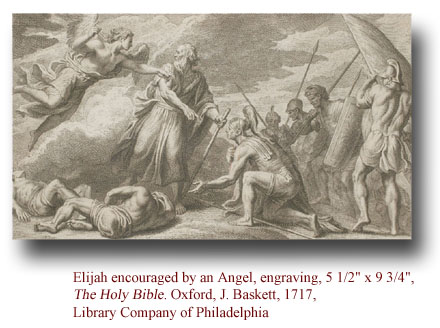
This exhibition explores the relationship between art and religion in America by presenting an overview of the variety and extent of scripturally related paintings from the colonial era through the eve of the Civil War. These works included examples of history painting, landscape, portraiture, genre painting, and fancy pieces. Americans experienced this art in a variety of ways ranging from public exhibitions of the paintings to reproductions in primers, bibles, gift books, and magazines. Despite the diversity of artistic expressions and venues, paintings of scriptural subject matter comprised a distinct area of endeavor. They deserve to be understood within their historical context and more fully integrated into the study of American art.
 The Scriptures of the Judeo-Christian tradition hold a unique position in American culture. For colonists who fled European religious persecution, they were a guide to faith and practice providing hope and insight into truth and the human condition. For the Revolutionary generation, with its Enlightenment dedication to self-reliance, optimism, and free-will, the language and imagery of the Scriptures offered a template for experience and an elevated vision of the nation's character and destiny. Franklin, for example, imagined a national seal showing Moses parting the Red Sea and leading the Israelites to safety. The idea of America as a chosen nation with a unique–indeed millennial–destiny quickened the religious and national aspirations of Americans. Biblical authority melded with democratic ideals as a series of religious revivals between the 1790s and the 1830s gave rise to a proliferation of self-determining Protestant sects and the growth of religious conceptions in the public arena. If the prominence of the Scriptures during this period of population growth and geographic expansion made them vulnerable to being linked to questionable agendas or expressions of self-righteousness, their principles also shaped the great social reform movements of the 1850s. American art came of age during this period and scriptural imagery and concerns were part of this development.
The Scriptures of the Judeo-Christian tradition hold a unique position in American culture. For colonists who fled European religious persecution, they were a guide to faith and practice providing hope and insight into truth and the human condition. For the Revolutionary generation, with its Enlightenment dedication to self-reliance, optimism, and free-will, the language and imagery of the Scriptures offered a template for experience and an elevated vision of the nation's character and destiny. Franklin, for example, imagined a national seal showing Moses parting the Red Sea and leading the Israelites to safety. The idea of America as a chosen nation with a unique–indeed millennial–destiny quickened the religious and national aspirations of Americans. Biblical authority melded with democratic ideals as a series of religious revivals between the 1790s and the 1830s gave rise to a proliferation of self-determining Protestant sects and the growth of religious conceptions in the public arena. If the prominence of the Scriptures during this period of population growth and geographic expansion made them vulnerable to being linked to questionable agendas or expressions of self-righteousness, their principles also shaped the great social reform movements of the 1850s. American art came of age during this period and scriptural imagery and concerns were part of this development.
